Brixton tube station
Brixton's bustling transport hub (by editor, updated Oct 2013)
INFO: For first/last tube train times and other Brixton tube/train/transport information, please check out our Brixton transport guide - click here.
Brixton Tube station is the southern terminus of the Victoria tube line and it has seen a huge rise in passengers numbers in recent years: up from 27.22m annual entries and exits in 2013 to 33.46m in 2016.
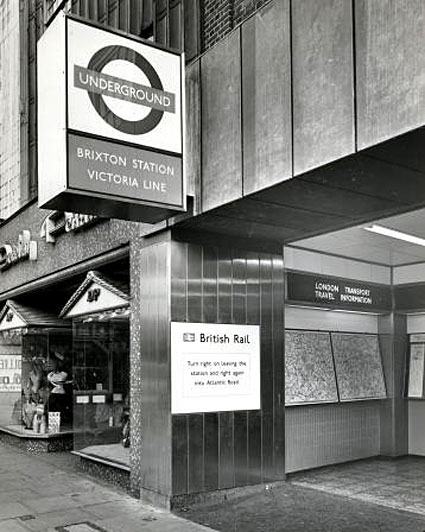
The shiny street entrance to Brixton Underground station a month after opening in August 1971 with its "illuminated roundel and lead fascia" and bus route maps usefully located inside the entrance. A Dorothy Perkins shop can be seen to the left. (Pic: LT Museum).
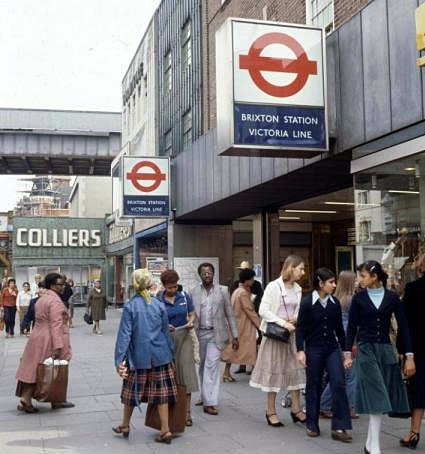
Brixton tube station, 1980 (photo: LT Museum
Located in Brixton Road in the centre of Brixton, the station is a two minute walk from the nearby high level railway station (on the London Victoria to Orpington line, operated by South Eastern), with buses galore stopping opposite and further up the street.
The tube ticket hall is situated a short flight of steps below street level, with three escalators taking passengers to and from the platforms (when they're working, of course.)
Trains can arrive and depart at either of the two subterranean platforms but if there's no trains in the station, wait between the platforms as the 'next train' indicator often points to the wrong platform!
Although Brixton is a terminus, it appears to be on a through route with tunnels each end of the platform. We're still looking for a definitive answer on this, but it seems that the southernly tracks extend 'half way to Herne Hill'.
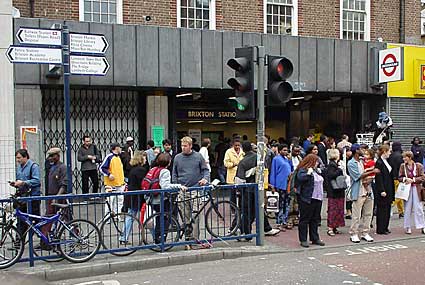
Brixton tube station, Sept 2000

Tube line facts!
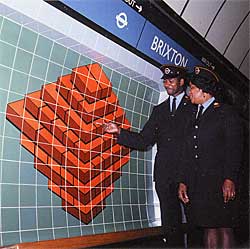
The joke may have proved a tad too subtle for some, but the tiled pattern being admired in this 1969 publicity shot is mosaic artist Hans Unger's visual pun on the station name. The design is called a 'ton of bricks'.
The Victoria line runs entirely underground (except for the maintenance depot at Northumberland Park) and covers 21km (13.25 miles) and serves 16 stations.
The line was constructed with increased tunnel diameters to reduce air resistance, with the tube varying between 3.71m (12'2") and 3.86m (12'8") in diameter, depending on the type of lining (concrete, bolted iron, flexible iron),
The line operates 43 trains, of which 37 trains are needed for service in the peak periods. The fleet was specially designed for the line and goes under the snappy moniker of the '1967 tube stock'.
The trains were manufactured by the famous Metro-Cammell of Birmingham, with each train made up of eight cars. The trains were later refurbished by Tickford Rail Ltd at Rosyth Royal Dockyard between 1991-1995.
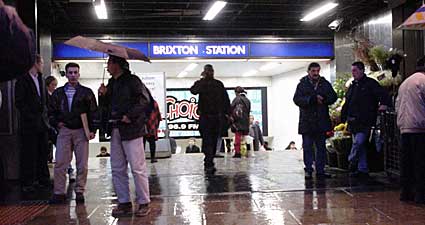
Station entrance, September 2000
Because the line was created to interconnect with existing lines, it has an unusually large proportion of interchanges with every station but one linking with National Rail or Underground links.
On a good day, the journey from Brixton to Walthamstow takes 32 minutes with trains running every two minutes during peak periods in each direction.
Keen to emulate the popularity of the 'Bakerloo' name, attempts were made to dream up a memorable name.
Happily, the two chosen front runners - the 'Viking Line' and the 'Walvic Line' - failed to capture the imagination, and so the line was rather unspectacularly named the 'Victoria Line.'
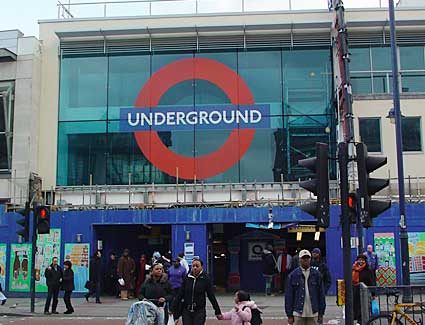
The rebuilt Brixton tube station nearing completion, July 2004
A world first!
The Victoria Line can lay claim to being the first automatic passenger railway in the world. A cunning system takes over once the
Train Operator has closed the train doors and pressed the start buttons, with trains running automatically to the next station, responding to coded impulses transmitted through the track.

History
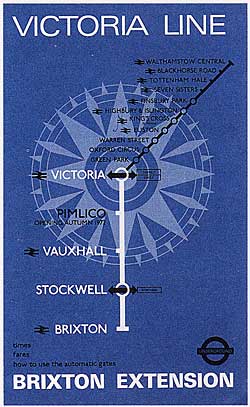
In 1943, the 'County of London Plan' proposed a major new underground tube line, running from Walthamstow to Brixton and connecting the mainline rail terminals of Kings Cross/St Pancras, Euston and Victoria.
The constraints of the war years and the subsequent re-organisation and nationalisation of London's transport caused the plan to be postponed, and Parliamentary Powers to build the line were not obtained until 1955.
Further delays in obtaining funds meant that actual construction work did not start until 1962.
The first deep-level Underground line to be built across central London since the 'tube boom' of 1905-1907, the line finally opened in stages between 1968 and 1971, with Brixton station officially being opened by Princess Alexandra on 23 July 1971 (see London Underground poster opposite).
There have been persistent rumours of plans to extend the line past Brixton, with a station under Herne Hill mainline station.
We won't be holding our breath on that one!
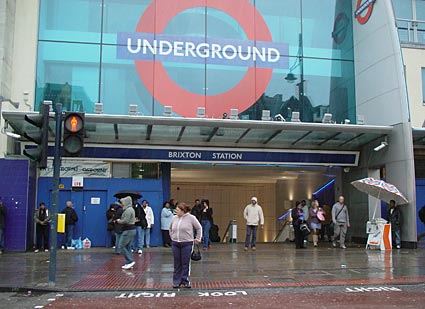
Brixton tube, Oct 2005. Still not fully completed with the lift yet to be commissioned.

Let's get classical
First time visitors should be warned that things can get mighty lively around the station entrance, with drug dealers, religious fanatics, incense sellers, hustlers, dodgy CD sellers, handbag 'dippers' and random alcoholics all adding 'character' to your journey.
In a novel attempt to drive disorderly teenagers off the station, London Underground started
piping endless recitals of 'uncool' classical music in the booking hall in December, 2005.
Armed with recordings of Pavarotti recitals, Vivaldi and Mozart, LU discovered that trials at four east London stations resulted in a 33% drop in abuse against staff.
A LU spokeswoman explains: 'This is aimed at youths, mainly young teenagers who hang about at stations. The science seems to be that the music is unfamiliar to them and also that it's considered uncool.'
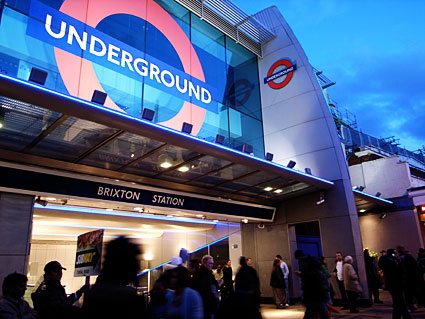
Station entrance, 2007
« back to features homepage Brixton travel info »
|
|

